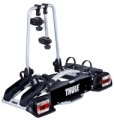Load capacity
The maximum weight that is allowed to be carried on the boot.
It is definitely not worth exceeding this parameter — even if the structure does not break immediately, this can happen at any time due to off-design loads. And ideally, you should have some margin for carrying capacity — this will give an additional guarantee in case of emergency situations (like hitting a wheel in a hole at speed).
Also note that the weight of the intended load must be supported not only by the boot itself, but also by the crossbars on which it is installed (if this installation option is used, see above). Moreover, the weight of both the cargo and the boot falls on the crossbars, which requires an even greater margin for load for them.
As for specific carrying capacity indicators, in general, the indicator
up to 50 kg is considered relatively low,
51 – 75 kg — average,
76 – 100 kg — above average, and in the most "heavy" models, the permissible load weight
exceeds 100 kg.
Material
The main material used in the construction of the boot. For boxes (see "Type"), the material of the container is indicated here, for crossbars — the material of the rails, etc.
— Steel. The main advantages of steel are high strength and reliability; in addition, the price of this material is low. There is also a drawback: steel structures are quite heavy, which accordingly affects fuel consumption. At the same time, the difference in weight with aluminium analogues is usually not so great that this disadvantage can be considered critical.
— Aluminium. Most of the aluminium alloys used in modern boots combine good strength and corrosion resistance with low weight (the latter helps save fuel). However such structures are more expensive than steel ones.
— Plastic. Plastic is characterized by low cost, combined with good strength, corrosion resistance, ease of processing and low weight. In terms of reliability, it is somewhat inferior to metals, but this moment becomes significant only at high loads. Therefore, plastic is practically not used in crossbars and open boots (see "Type"), but it is quite suitable for other types — except, perhaps, for the most load-bearing models.
— Fibreglass. Material based on glass threads. Unlike ordinary glass, such threads do not break or break, but instead are able to bend easily. The fibreglass used in car boots is notable for its high strength and low weight, but it is also quite expensive, and...therefore is found mainly among premium models.
— Textile. The fabric is mainly used for boxes (see "Type"). Such products have a soft container that resembles a tourist backpack (and the fabric itself usually belongs to the “tourist” varieties — nylon or polyester). The main advantage of this material is the ability to roll an unused boot into a fairly compact roll; and the weight of the structure is quite small. On the other hand, in terms of aerodynamic properties and degree of protection, soft boxes lose out to hard ones, and this material is practically inapplicable in other types of boots.
External dimensions (LxWxH)
Boot dimensions in working position; usually indicated for open models and boxes (see "Type"). The capacity of the product directly depends on this parameter, in particular, its suitability for transporting large items. And in the case of boxes, dimensions also affect aerodynamics: increasing the height or width increases drag and fuel consumption. At the same time, it should be noted that the aerodynamics of the container also largely depends on its shape.
For open boots, the height is most often not indicated — after all, its actual value usually depends not on the dimensions of the structure, but on the size of the cargo being transported.
Weight
Net weight of the boot in working (fully assembled) form.
The light weight contributes to fuel economy (especially during long-term use) and also makes it easier to transport the boot outside the car (for example, from storage to the car and back). On the other hand, lightening the product leads either to a decrease in its strength and load capacity, or to an increase in cost. So in certain situations, a relatively heavy boot may be the best choice; and when choosing a light model, you should pay special attention to the claimed load capacity.

